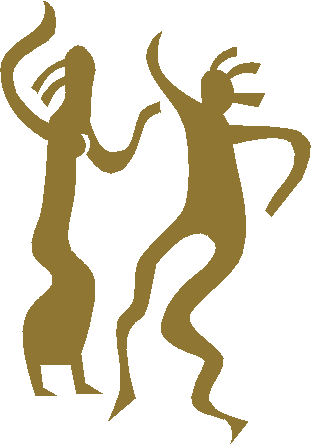HOW
DANCES BEGIN  Ballroom dancing is one of several social activities which cannot be cut
off from the world and its environment. It is a living thing influenced by local and world
events, and sensitive to changes going on around it. War, fashion, music, increased
mobility, social upheavals, popularity of film and television, new attitudes, women’s
liberation -- all these have had repercussions on the dancing scene. Ballroom dancing is one of several social activities which cannot be cut
off from the world and its environment. It is a living thing influenced by local and world
events, and sensitive to changes going on around it. War, fashion, music, increased
mobility, social upheavals, popularity of film and television, new attitudes, women’s
liberation -- all these have had repercussions on the dancing scene.
Like any other living thing, a
dance must develop and grow, or disappear. It cannot remain unchanged. Once a
popular dance becomes staid and standard that it stops growing, its days would be
numbered. They would then be shelved just like other one-time popular dances as the
minuet, gavotte, mazurka, schottische, the polka, and in recent years, the Big Apple,
Lambeth Walk, Mashed Potato, the Stroll, and the Twist. The Twist though, and a few
others such as the Lindy, are still used as variations or syncopations of other popular
dances.
What then are the
characteristics of a dance which turn out to be a hit?
The first is an easily
recognizable and ear-catching rhythm which must be
absolutely new to the ballroom. A new dance is born of a new rhythm. So far we cannot
trace any rhythm ever returning to take on a second lease of life.
Such dances as the Waltz, Tango and
Foxtrot, were all rhythms new to the ballroom when they were introduced. These dances were
also characterized by a rhythm in a usual and familiar time of 2/4, 3/4, or 4/4, which
made them easily recognizable by people.
Another characteristic of a
successful dance is that its rhythm should be such that the steps of no existing dance can
be satisfactorily fitted to it without some subtle change to alter the whole nature of the
steps. Social dancers for instance had so much difficulty with the Rumba, until bands
started to play music with the true feeling of Latin America, and not some tune very
much like the Foxtrot.
Where did the rhythm of dances
which became popular come from? As far as it can be traced, in every case it comes from a
folk dance. Over centuries every kind of rhythm was tried out, many being discarded, some
going on to become popular dances.
The Minuet and the Gavotte came
from the peasants of Poitou and Provence, respectively, both in France. The Waltz
originated from the Lšndler or folk songs of southern Germany, while the Polka came from
Bohemia.
In North America, many of the
rhythms came from the colored people, such as the Foxtrot, a rhythm which had its origin
in Africa.
From Latin America,
rhythms such as the Tango from the Argentine, the Rumba, the Cha Cha Cha and the Samba
have become favorites worldwide.
Contrary to the belief of many
dancers, the actual steps of a new dance are not particularly important. As a prominent
British dance teacher writes: “In the past, the steps associated with a new dance in
the early days of its ballroom career rarely proved a permanent part of the dance. Quite
often they were complicated and sometimes positively eccentric. Even when taken from
the original folk dance they needed a good deal of adaptation to become acceptable in the
smart ballrooms of their day.
Citing Victor Silvester in his book "Modern Ballroom Dancing":
“The original steps of the
Minuet, the Gavotte, the Waltz, the Polka, the Tango and the Foxtrot differed considerably
from those used when the dances were at the height of their popularity. However, although
the first steps are not of prime importance, of course they must be in keeping with the
spirit of their times; no one would expect the mincing steps of the Minuet to last five
minutes in the ballroom today.
“As soon as a new dance
appears, its steps are tried by hundreds of dancers and teachers. In the light of
their impressions, modifications will probably be made: movements changed or omitted, or
new ones included, much as it happened in the days of the Minuet and the Waltz.
“The manner in which a
new dance spreads socially is interesting; in its country of origin, from being a folk
dance of the people, a simple, fascinating rhythm moves on to be taken up, in a modified
form, by the sophisticated. In other countries, the very opposite happens. The dance is
picked up on its own ground by holiday makers and travelers and taken back, to catch on in
their home countries.
“For the last four or
five hundred years, this has been the pattern of movement followed by all successful
ballroom dances.”
And as in the case in the Philippines,
these same dances are further modified through use of a different music, tempo, and
additional or new step patterns.

|
